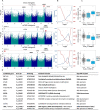Genetic and environmental drivers of large-scale epigenetic variation in Thlaspi arvense
- PMID: 36223399
- PMCID: PMC9591053
- DOI: 10.1371/journal.pgen.1010452
Genetic and environmental drivers of large-scale epigenetic variation in Thlaspi arvense
Abstract
Natural plant populations often harbour substantial heritable variation in DNA methylation. However, a thorough understanding of the genetic and environmental drivers of this epigenetic variation requires large-scale and high-resolution data, which currently exist only for a few model species. Here, we studied 207 lines of the annual weed Thlaspi arvense (field pennycress), collected across a large latitudinal gradient in Europe and propagated in a common environment. By screening for variation in DNA sequence and DNA methylation using whole-genome (bisulfite) sequencing, we found significant epigenetic population structure across Europe. Average levels of DNA methylation were strongly context-dependent, with highest DNA methylation in CG context, particularly in transposable elements and in intergenic regions. Residual DNA methylation variation within all contexts was associated with genetic variants, which often co-localized with annotated methylation machinery genes but also with new candidates. Variation in DNA methylation was also significantly associated with climate of origin, with methylation levels being lower in colder regions and in more variable climates. Finally, we used variance decomposition to assess genetic versus environmental associations with differentially methylated regions (DMRs). We found that while genetic variation was generally the strongest predictor of DMRs, the strength of environmental associations increased from CG to CHG and CHH, with climate-of-origin as the strongest predictor in about one third of the CHH DMRs. In summary, our data show that natural epigenetic variation in Thlaspi arvense is significantly associated with both DNA sequence and environment of origin, and that the relative importance of the two factors strongly depends on the sequence context of DNA methylation. T. arvense is an emerging biofuel and winter cover crop; our results may hence be relevant for breeding efforts and agricultural practices in the context of rapidly changing environmental conditions.
Conflict of interest statement
The authors have declared that no competing interests exist.
Figures





Similar articles
-
Discarded sequencing reads uncover natural variation in pest resistance in Thlaspi arvense.Elife. 2024 Dec 19;13:RP95510. doi: 10.7554/eLife.95510. Elife. 2024. PMID: 39699583 Free PMC article.
-
Spatial genetic and epigenetic structure of Thlaspi arvense (field pennycress) in China.Genes Genet Syst. 2021 Feb 11;95(5):225-234. doi: 10.1266/ggs.20-00025. Epub 2020 Nov 11. Genes Genet Syst. 2021. PMID: 33177249
-
A draft genome of field pennycress (Thlaspi arvense) provides tools for the domestication of a new winter biofuel crop.DNA Res. 2015 Apr;22(2):121-31. doi: 10.1093/dnares/dsu045. Epub 2015 Jan 27. DNA Res. 2015. PMID: 25632110 Free PMC article.
-
New approaches to facilitate rapid domestication of a wild plant to an oilseed crop: example pennycress (Thlaspi arvense L.).Plant Sci. 2014 Oct;227:122-32. doi: 10.1016/j.plantsci.2014.07.008. Epub 2014 Aug 4. Plant Sci. 2014. PMID: 25219314 Review.
-
Potential insect threats to pennycress, Thlaspi arvense (Brassicales: Brassicaceae), an emerging oilseed cover crop.J Insect Sci. 2024 Jul 1;24(4):17. doi: 10.1093/jisesa/ieae086. J Insect Sci. 2024. PMID: 39189128 Free PMC article. Review.
Cited by
-
Herbivory induced methylation changes in the Lombardy poplar: A comparison of results obtained by epiGBS and WGBS.PLoS One. 2023 Sep 8;18(9):e0291202. doi: 10.1371/journal.pone.0291202. eCollection 2023. PLoS One. 2023. PMID: 37682835 Free PMC article.
-
Transposon dynamics in the emerging oilseed crop Thlaspi arvense.PLoS Genet. 2024 Jan 31;20(1):e1011141. doi: 10.1371/journal.pgen.1011141. eCollection 2024 Jan. PLoS Genet. 2024. PMID: 38295109 Free PMC article.
-
The evolutionary consequences of interactions between the epigenome, the genome and the environment.Evol Appl. 2024 Jul 23;17(7):e13730. doi: 10.1111/eva.13730. eCollection 2024 Jul. Evol Appl. 2024. PMID: 39050763 Free PMC article. Review.
-
Epigenomic and transcriptomic persistence of heat stress memory in strawberry (Fragaria vesca).BMC Plant Biol. 2024 May 16;24(1):405. doi: 10.1186/s12870-024-05093-6. BMC Plant Biol. 2024. PMID: 38750420 Free PMC article.
-
Subfunctionalization and epigenetic regulation of a biosynthetic gene cluster in Solanaceae.Proc Natl Acad Sci U S A. 2025 Feb 25;122(8):e2420164122. doi: 10.1073/pnas.2420164122. Epub 2025 Feb 20. Proc Natl Acad Sci U S A. 2025. PMID: 39977312 Free PMC article.
References
-
- Becker C, Hagmann J, Müller J, Koenig D, Stegle O, Borgwardt K, et al.. Spontaneous epigenetic variation in the Arabidopsis thaliana methylome. Nature. 2011. Dec;480(7376):245–9. - PubMed
-
- He Y, Li Z. Epigenetic Environmental Memories in Plants: Establishment, Maintenance, and Reprogramming. Trends in Genetics. 2018. Aug 22; Available from: http://www.sciencedirect.com/science/article/pii/S0168952518301276 - PubMed
Publication types
MeSH terms
Substances
LinkOut - more resources
Full Text Sources

